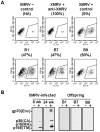Long-term infection and vertical transmission of a gammaretrovirus in a foreign host species
- PMID: 22235324
- PMCID: PMC3250474
- DOI: 10.1371/journal.pone.0029682
Long-term infection and vertical transmission of a gammaretrovirus in a foreign host species
Abstract
Increasing evidence has indicated natural transspecies transmission of gammaretroviruses; however, viral-host interactions after initial xeno-exposure remain poorly understood. Potential association of xenotropic murine leukemia virus-related virus (XMRV) in patients with prostate cancer and chronic fatigue syndrome has attracted broad interests in this topic. Although recent studies have indicated that XMRV is unlikely a human pathogen, further understanding of XMRV xenoinfection would allow in vivo modeling of the initial steps of gammaretroviral interspecies transmission, evolution and dissemination in a new host population. In this study, we monitored the long-term consequences of XMRV infection and its possible vertical transmission in a permissive foreign host, wild-derived Mus pahari mice. One year post-infection, XMRV-infected mice showed no notable pathological changes, while proviral DNA was detected in three out of eight mice. XMRV-infected mice remained seropositive throughout the study although the levels of gp70 Env- and p30 capsid-specific antibodies gradually decreased. When vertical XMRV transmission was assessed, no viremia, humoral immune responses nor endogenization were observed in nine offspring from infected mothers, yet one offspring was found PCR-positive for XMRV-specific sequences. Amplified viral sequences from the offspring showed several mutations, including one amino acid deletion in the receptor binding domain of Env SU. Our results therefore demonstrate long-term asymptomatic infection, low incidence of vertical transmission and limited evolution of XMRV upon transspecies infection of a permissive new host, Mus pahari.
Conflict of interest statement
Figures



Similar articles
-
Early events in retrovirus XMRV infection of the wild-derived mouse Mus pahari.J Virol. 2011 Feb;85(3):1205-13. doi: 10.1128/JVI.00886-10. Epub 2010 Nov 17. J Virol. 2011. PMID: 21084477 Free PMC article.
-
Infection, viral dissemination, and antibody responses of rhesus macaques exposed to the human gammaretrovirus XMRV.J Virol. 2011 May;85(9):4547-57. doi: 10.1128/JVI.02411-10. Epub 2011 Feb 16. J Virol. 2011. PMID: 21325416 Free PMC article.
-
Antibody responses against xenotropic murine leukemia virus-related virus envelope in a murine model.PLoS One. 2011 Apr 6;6(4):e18272. doi: 10.1371/journal.pone.0018272. PLoS One. 2011. PMID: 21494670 Free PMC article.
-
The human retrovirus XMRV in prostate cancer and chronic fatigue syndrome.Nat Rev Urol. 2010 Jul;7(7):392-402. doi: 10.1038/nrurol.2010.77. Epub 2010 Jun 1. Nat Rev Urol. 2010. PMID: 20517289 Review.
-
Xenotropic Murine Leukemia Virus-Related Virus (XMRV) and the Safety of the Blood Supply.Clin Microbiol Rev. 2016 Oct;29(4):749-57. doi: 10.1128/CMR.00086-15. Clin Microbiol Rev. 2016. PMID: 27358491 Free PMC article. Review.
Cited by
-
The saga of XMRV: a virus that infects human cells but is not a human virus.Emerg Microbes Infect. 2014 Apr;3(4):e. doi: 10.1038/emi.2014.25. Epub 2014 Apr 9. Emerg Microbes Infect. 2014. PMID: 26038516 Free PMC article. Review.
-
No evidence of xenotropic murine leukemia virus-related virus transmission by blood transfusion from infected rhesus macaques.J Virol. 2013 Feb;87(4):2278-86. doi: 10.1128/JVI.02326-12. Epub 2012 Dec 12. J Virol. 2013. PMID: 23236064 Free PMC article.
-
Gammaretrovirus-specific antibodies in free-ranging and captive Namibian cheetahs.Clin Vaccine Immunol. 2015 Jun;22(6):611-7. doi: 10.1128/CVI.00705-14. Epub 2015 Mar 25. Clin Vaccine Immunol. 2015. PMID: 25809630 Free PMC article.
References
-
- Hardy WD, Jr, Old LJ, Hess PW, Essex M, Cotter S. Horizontal transmission of feline leukaemia virus. Nature. 1973;244:266–269. - PubMed
-
- Buffett RF, Grace JT, Jr, DiBerardino LA, Mirand EA. Vertical transmission of murine leukemia virus through successive generations. Cancer Res. 1969;29:596–602. - PubMed
-
- Duggan J, Okonta H, Chakraborty J. Vertical transmission of a murine retrovirus, ts1. Viral Immunol. 2004;17:266–278. - PubMed
Publication types
MeSH terms
Substances
Grants and funding
LinkOut - more resources
Full Text Sources
Molecular Biology Databases
Research Materials

